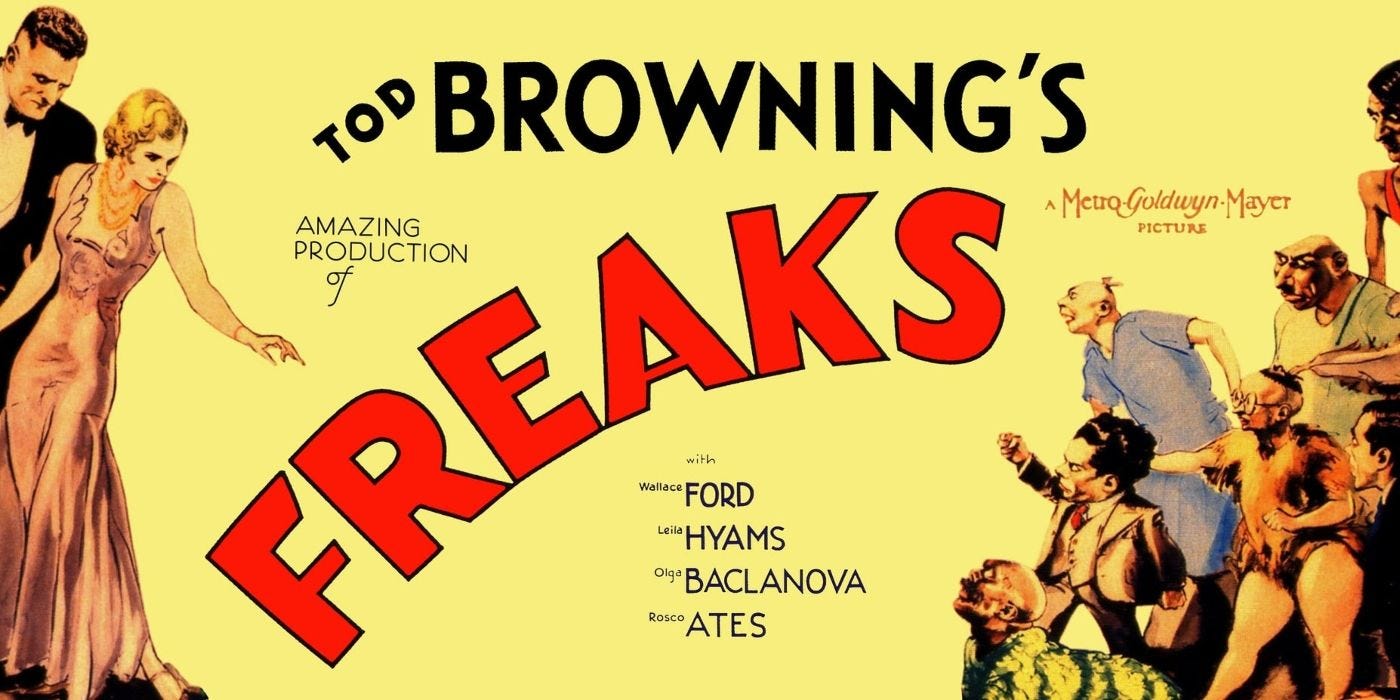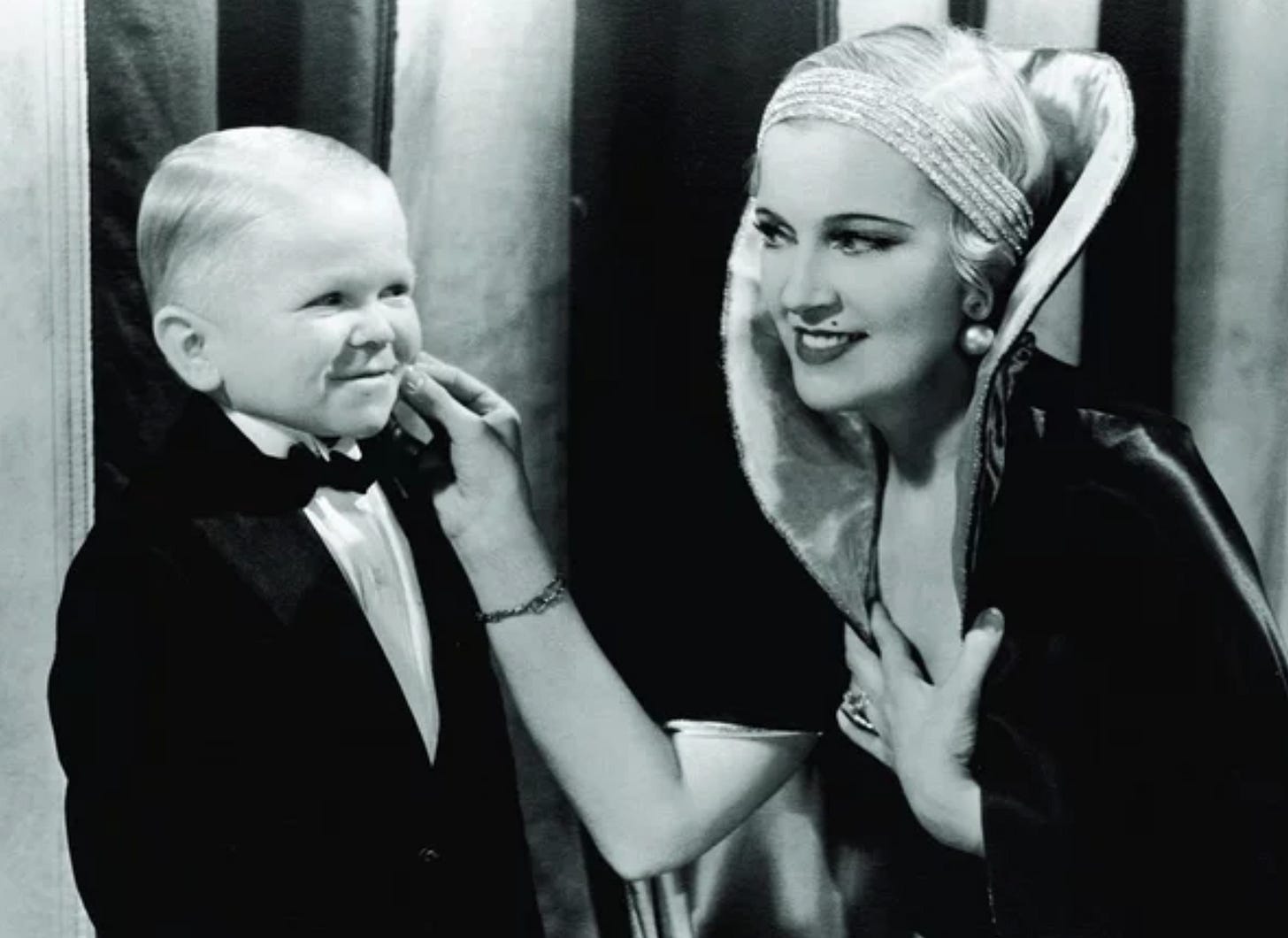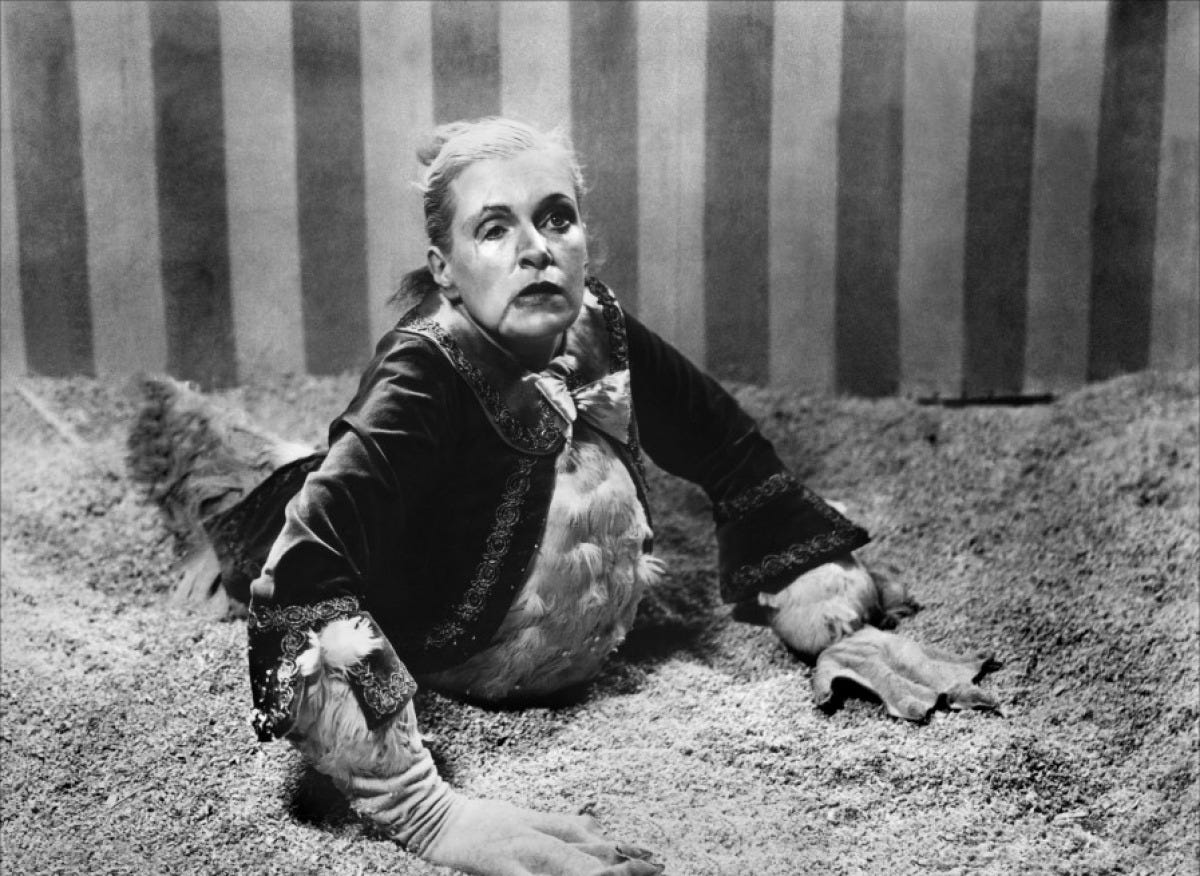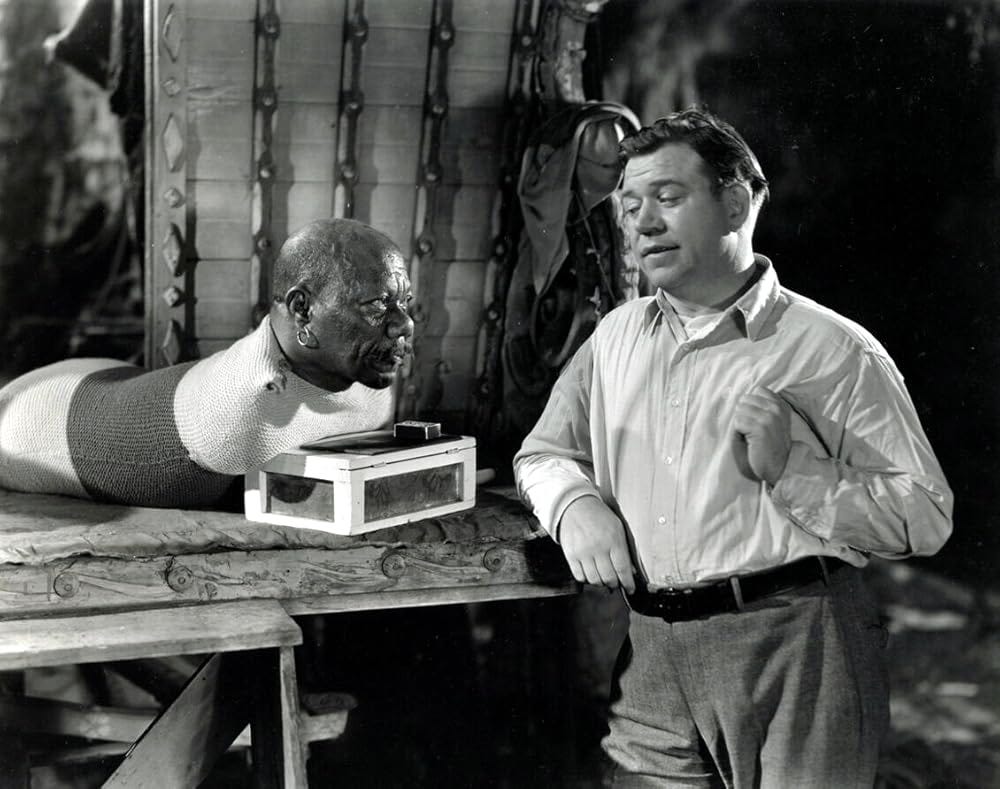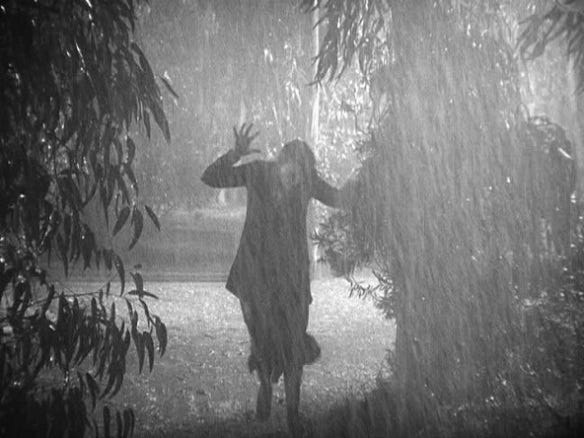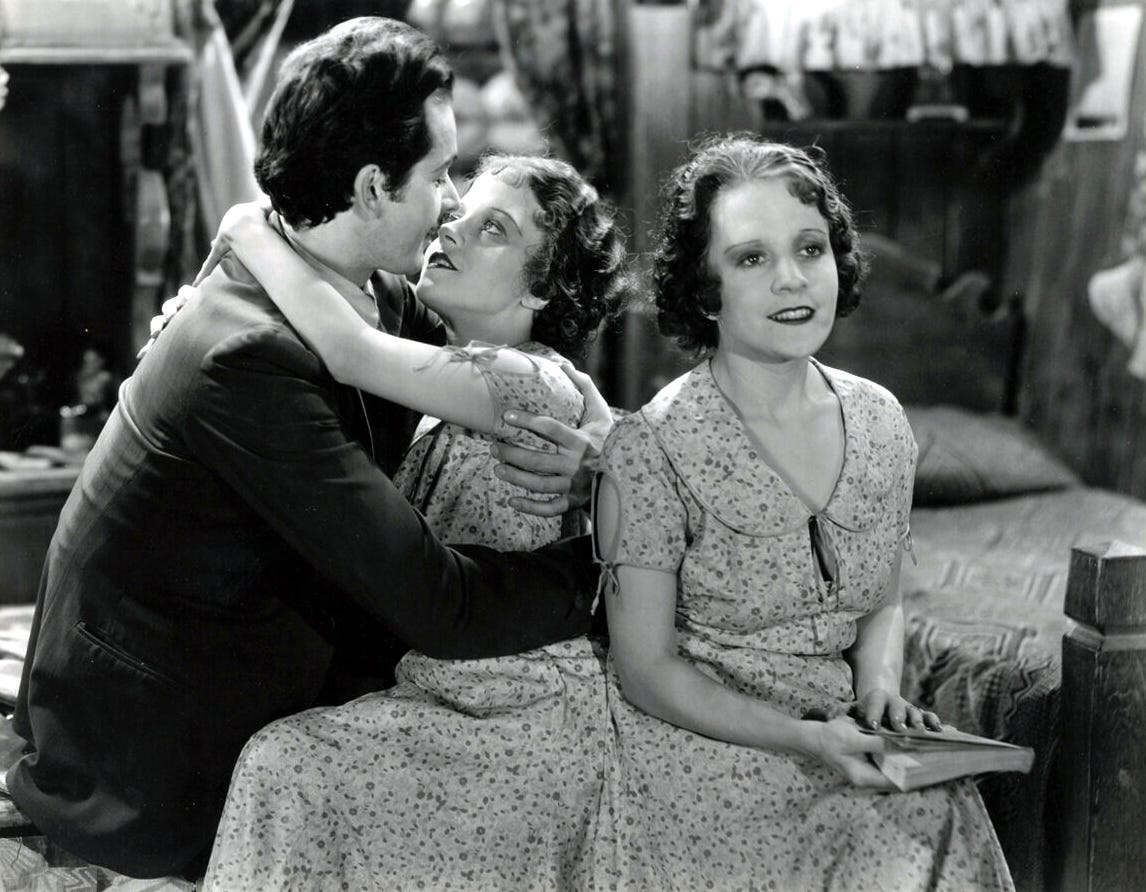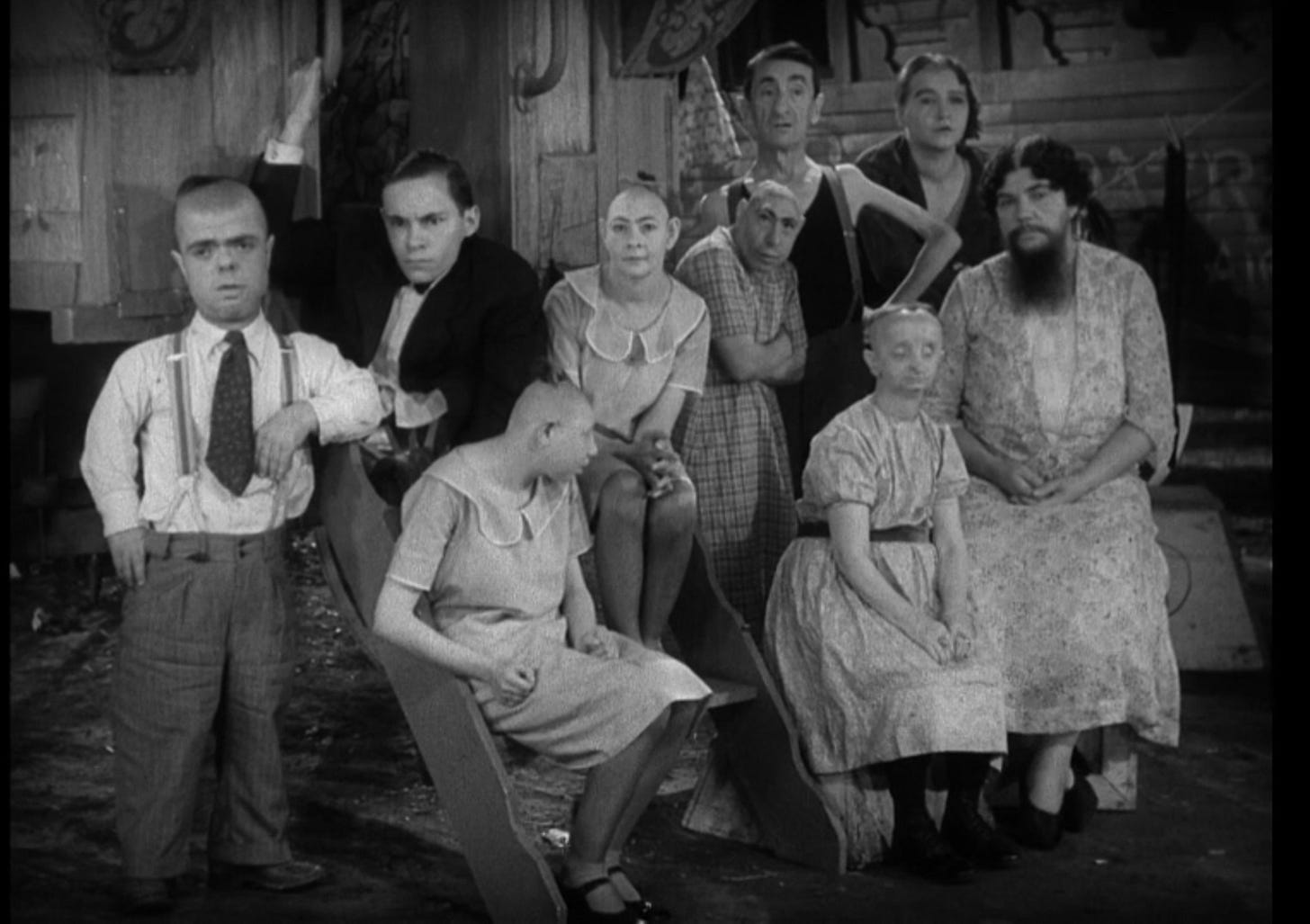GAZE No. 1: Freaks (1932), Disability, and Being
Welcome to the first edition of GAZE, a newsletter about film theory.
In each edition of GAZE, I will be examining a piece of media through the lens of psychoanalytic film theory. We will begin with Sartre and Lacan in an analysis of Tod Browning’s Freaks (1932).
Table of contents:
Part 1: Introduction
Part 2: The Show vs the Freaks and Villainy
Part 3: Dichotomy, Cleo’s Being, and Sartre
Part 4: The Roles of the Freaks: Earnest Comedy
Part 5: Conclusion
Part 1: Introduction
Freaks, based on the short story “Spurs” by Tod Robbins, was released in late February 1932. After being purchased by Metro-Goldwyn-Mayer for production in the early 1930s, Tod Browning (Dracula, London After Midnight) was slated to direct. He was an apt choice; he had a history in the circus and had already achieved moderate success in Hollywood’s early sound era. Freaks, however, was released to poor test screenings and critical panning, considered too explicit a display of the physically disabled body. The audiences of the early 30s simply were not prepared for such a frank and unapologetic portrayal of the daily lives of the disabled, nor were they prepared for the able-bodied antagonist’s fate. After several disastrous showings, some of which allegedly saw viewers running screaming from the theater, thirty minutes of the hour-and-a-half runtime were cut by MGM censors. This portion of the film has not been recovered since, but what remains of Freaks is a puzzling, daring, actually quite funny sixty-two minute film. There is much to discuss, Browning’s film is an astoundingly progressive representation of the disabled, especially in the 1930s when eugenicist theory was on the rise internationally. Browning’s career was left in ruins after Freaks, which was a box office failure. He died in 1962, aged 82, blacklisted from the industry and having abandoned his talent and passion for filmmaking in 1939. Freaks was swiftly banned in the United Kingdom and parts of the United States for up to thirty years after its release, and when it was rereleased it was to limited distribution. As of 2025, nearly 100 years after its release, Freaks remains the only American film to feature a predominantly disabled cast.
Part 2: The Show vs the Freaks and Villainy
I argue that Freaks is everything but exploitative. The film has very little to do with the freak show and far more to do with the lives of the Freaks themselves. The group cast features distinct characterization that goes beyond caricature, depicts compelling interpersonal relations, with many threads overlapping. The antagonists of this film are Cleopatra, the trapeze artist, and Hercules, the bullfighter. Both are able-bodied and are extremely cruel to the Freaks. They hide their mocking to the best of their ability, but the audience is aware of their teasing from the beginning. Cleopatra’s punishment (that is, being turned into a Freak herself) is distinctly satisfying because to her it was the worst possible outcome. Ideologically, this film’s stance is that being turned into a Freak is not necessarily a fate worse than death, Freaks in fact insists that the Freaks are worthy of life, that they can live it just as fully as the able-bodied. Cleo’s continued insistence on the supposed monstrousness of the Freaks, combined with her attempted murder of Hans, results in her disfigurement by the Freaks and her confinement to a pen on the ground where she remains unable to speak or move except with erratic, panicked squawks. The film’s radical subversion is seen here: Cleo’s characterization and physicality throughout the film’s stark contrast, the immeasurable difference between her able-body and her chicken-body. The white, blonde, conventionally attractive woman (archetypically the love interest or audience surrogate) is a morally reprehensible attempted murderer and is framed as deserving her fate. She gets her penance in the end; the pays the ultimate price for her cruelty and exploitation: the mutilation of her entire body and the removal of her ability to speak.
Hercules is not involved in the conciet of Cleo’s schemes. Though he participates, seems to be an active player in them, he has nothing to do with their inception. He is like Cleo: shallow, deceptive, rude, and taunting at every opportunity. Cleo is attracted to Hercules in actuality, but pretends to be in love with Hans, insisting on marrying him and acting giddy in love until the wedding dinner. There, she attempts to poison him to kill him for his money. At the dinner, the Freaks begin to chant “we accept her, we accept her, one of us, one of us!” and Cleo absolutely cannot handle it. She is disgusted by the presence of the Freaks and the fact that they are implying she could be welcome in their small, tight knit community. The audience of the 1930s were used to seeing characters who look like Cleo and Hercules featuring the starring roles, and it was clearly unsettling to see characters who may be expected to be the “good guys” act maniacal, taunting, and shameless in their mistreatment of the Freaks (they do this especially when intoxicated). To Cleo, there is nothing worse than being a Freak, which is why the ending is so satisfying. She never thought of them as human, she lacks empathy for them and is thus evil. She has no redemption or a redeeming quality, that’s why the Freaks decide to prolong her suffering and make her live a life of being gawked at, being the subject of horrified screams and hysterical tears. The film in this way incriminates the audience who are biased against the Freaks already. It made them feel guilty and complicit, they were disturbed by the very presence of the Freaks. All along, Cleopatra really was the audience surrogate. The open disgust is nothing but an externalization of the attitude of the 30s and the systemic issues oppressing the disabled.
Part 3: Dichotomy, Cleo’s Being, and Sartre
Interestingly enough, Cleo (able bodied as she is) is sometimes posed as less able than the Freaks. They have skills that the able bodied could never accomplish for lack of necessity. For example, Prince Randian, The Living Torso, can strike a match and start a cigarette with his mouth alone, or the armless girl who is adept at holding her utensils and wine glasses with her feet. The film makes clear there are a multitude of ways the Freaks are perfectly capable of living, coping with their disability and not considering it a death sentence or even a depressing fact of life. They have lived their entire lives with their “freakishness", and their behaviors are positioned as not only necessity but as admirable testaments to character. This is one of the film’s most rebellious stances. Cleo, despite her tall athleticism, succumbs to the Freaks’ attack. They ultimately overtake her, outsmart her with their own plot, and bring her scheming, mocking ways to a decisive end. In silencing her, the film effectively punishes the entire audience.
Cleo is a conniving, manipulative villain. It seems she has been scheming to get Hans’s money for a long time, at least prior t o the events of the film. Hans, deeply in love with her and always buying her luxuries, is unaware of her laughing behind his back. She is purely in it for the jewelry and the money, she is in fact disgusted by Hans and the Freaks. Her behavior is suggested to be evil because of this dynamic in particular. The Freaks are the metric for all the other characters’ good-ness. If one is kind to them, one is a good guy, and if one is not, one is a bad guy. The film operates with this strict dichotomy at its foundation, it is thus always easy to understand who the villains are.
Sartre, in his book Existential Psychoanalysis poses the following: “human reality identifies and defines itself by the ends which it pursues” (11). Cleo’s reality, then, has been defined by that which she pursued. Throughout the film she has pursued nothing but the exploitation of a man she deems a disgusting Freak (for the purposes of gaining financial status alone), she has now become the exploitable Freak herself. Cleo, one could say, is purely a “for-itself” (Sartre), that is, she lacks Being. The for-itself is the mode of human consciousness, distinct from the unconscious. Cleo is pure consciousness. She is nothing deeper, she has no indeterminate subject position. She has no unconscious wants, wishes or desires, her drive is purely based on greed; her entire personality revolves around a want for cash. Cleo projects her Being solely as a for-itself, a being “which is what it is” (Sartre, 39). She has no possibility outside of her Being being nothing, her Being is the pure for-itself. All of her actions are determinate. She is the for-itself as concept, is nothing but conscious wants. To Sartre, in each inclination or tendency, the subject expresses themselves completely, though only from a particular angle (Sartre, 33), meaning all of one’s intentions, the core of one’s relation to the world, is technically expressed in every spoken phrase, thought, or tendency. When we are speaking or doing, we are always expressing ourselves entirely, but we are not able to demonstrate every position our subjectivity might take. Cleo is evil, a villain, and that is her sole characteristic. She is cruel to the Freaks who do not deserve it, and her cruelty is framed as not only morally objectionable but flat out wrong, wrong to the point that her fate feels like karmic retribution. According to Sartre here, in every act of hatred against the Freaks, she constitutes herself completely. Her inability to empathize, her refusal to see them as human beings, her nature of being disgusted by them yet still interacting in the interest of making fun, all point to the fact that she exists solely in relation to her hatred for the Freaks. She is more than willing to sarcastically fawn over Hans whilst mocking him in actuality. Her every expression is a manifestation of the hatred and contempt she has for those who she finds abject and horrible. It is necessary to make Cleo cartoonishly evil, to make her scheming and relationship with Hercules markedly detestable, noticeably and deeply wrong, for that was the only way Browning could make the ideological subjects of the 1930s, biased against the Freaks at the outset, (in theory, potentially) root against her. Of course, this was not the response, but the text of the film is rather explicit in its messaging.
Part 4: The Roles of the Freaks: Earnest Comedy
Before the attack and conclusion (the shocking interjection of the Real, her mutilated half-chicken body) there are some somewhat tender and even heartwarming moments. For example, in one scene, the clown Phroso is shown to be kind to all of the Freaks including those who are not only physically disabled but mentally impaired as well. His conversation with Schlitzie, played by the sideshow performer Pin Head, is quite sweet. He tells her he’ll buy her a hat with a big feather on it, she giggles and one can see she is absolutely delighted. The scene is not played as comic or demeaning, it is framed as sweet, cute, an expression of decent humanity. There is a general communical kindness that many of the performers treat each other with, and there are several depictions of disabled peoples in relationships, some of which are with able-bodied persons. The conjoined twins each have an able-bodied husband, whose contrasting features are played for laughs repeatedly. This is not an instance of the Freaks being laughed at, rather, the conjoined twins are the source of the jokes because their circumstance is inherently comedic. The twins have a dynamic with each other, with each of their husbands, and the husbands have a dynamic with each other: this already puts one in comic scenarios, and that is what’s funny. It’s not them being mocked for their existence or physicality. The comedy is sourced from the recognition of potential for humor in these scenarios, there are potential jokes because of their situation, but they are never the butt of the joke. The characters are shown to have deep interpersonal bonds and tensions, long histories, relationships with one another that are variable and nuanced, they are filled with love, sympathy, and genuine compassion, even between disabled and able bodies.
Freaks asserts unapologetically that the Freaks can live fulfilling and interesting lives specifically outside of the circus which, for all intents and purposes, is just their job. The film allows fly-on-the-wall access to a community normally off limits to us, one we would usually only see in the midst of their being-as-caricature. The crowd they would typically be performing for can be seen then as representative of reality. Freaks prioritizes the Real (see: the Lacanian Real) over reality. The circus performance is representative of civilzation, the social order which interjects the subject and the Real. The interposition constitutes the divide between them and their potential diegetic audience. The social order intrudes upon the Freaks’ very existence when they perform in the circus, leaning into their archetypal characterizations. This stereotyping is exlusive to the show, the performers explicitly do not align with the one-dimensional re-presentations in diegetic audience (and perhaps those attending the 1932 test screenings) are capable of grasping. Our inability to see the show they perform every day cultivates this sense that their participation in it has nothing to do with them as subjects, while it has everything to do with Cleopatra and Hercules. Depicted after-hours, large circus tents loom above the performers as they play cards or celebrate. The cast members in the film are showed filling their actual roles. Frida, for example, is seen doing the washing, a normal daily chore. This aspect of mundanity is often missing from film, but Freaks is full of it. The majority of the actors’ performances are in scenes depicting disabled daily life. In Freaks, the spectator is brought close to the Freaks as we see their poor treatment at every turn, mostly at the hands of Cleopatra and Hercules. The film’s concern is a simple matter of the manner in which the Freaks complete their daily tasks, how they live their lives as normal. Browning is particularly interested in the way each character manages living with their givin disability. The production is rather voyeuristic as the Freaks go about their daily lives, maneuver relationships, make jokes, and exist exterior to the bounds of the able bodies’ mandate. Unlike their stage personas, they are full and complete people. There is a Real essence of the human being which cannot be boiled down to a physique. The jokes laugh with the freaks or at the able bodied, and the film positions laughing at the freaks as a distinctive moral wrong. That is what distinguishes the spectator of the film from the diegetic audience (who are lost to us), our fundamental difference is in our ability to see past reality, despite it not being any choice of our own, rather it is a matter of Browning’s own design.
Part 5: Conclusion
Freaks, despite its critical and box office failure, remains a cult classic and, to me, a great filmic success. It is a well constructed film entirely aware of its perspective, it is making distinctive political commentary, and is not subtle in its messaging. The film is absolutely set in the stance that the Freaks (and thus disabled people on the whole) deserve a good, peaceful, and happy life. They deserve it as all humans do, and that’s what they are: human.
Find Freaks available to watch in 1080p on the Internet Archive here.


